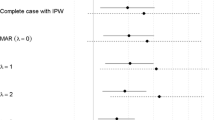Summary
In a recent survey of depressive symptoms among former prisoners of war, longitudinal data were used to estimate nonresponse bias. A predictive model was fitted to the data of current respondents and then was used to predict the scores of nonrespondents who had earlier provided similar covariate data. This analysis showed that, despite differences between respondents and nonrespondents in age, education, and severity of treatment during captivity, differences between the observed scores of respondents and the predicted scores of nonrespondents were small. For an estimation of the overall impact of nonresponse bias, revised estimates for the entire sample were calculated by combining observed data from respondents and predicted data for nonrespondents; the revised estimates differed little from those for respondents alone.
Similar content being viewed by others
References
Comstock GW, Helsing KJ (1973) Characteristics of respondents and nonrespondents to a questionnaire for estimating community mood. Am J Epidemiol 97: 233–239
Kaspryzk D, Duncan G, Kalton G (eds) (1989) Panel Surveys. John Wiley & Sons, New York
Cohen BM, Cooper MZ (1955) A follow-up study of World War II prisoners of war. VA Medical Monograph, Washington, DC
Nefzger MD (1970) Follow-up studies of World War II and Korean war prisoners. I. Study plan and mortality findings. Am J Epidemiol 91: 123–138
Beebe GW (1975) Follow-up studies of World War II and Korean war prisoners. II. Morbidity, Disability, and Maladjustments. Am J Epidemiol 101: 400–422
Keehn RJ (1980) Follow-up studies of World War II and Korean Conflict prisoners. III. Mortality to 1 January 1976. Am J Epidemiol 111: 194–211
Radloff LS (1977) The CES-D Scale: a self-report depression scale for research in the general population. Appl Psychol Meas 1: 385–401
Comstock GW, Helsing KJ (1976) Symptoms of depression in two communities. Psychol Med 6: 551–563
Eaton WW, Kessler LG (1981) Rates of symptoms of depression in a national sample. Am J Epidemiol 114: 528–538
Frerichs RR, et al (1981) Prevalence of depression in Los Angeles County. Am J Epidemiol 113: 691–699
Vernon SW, et al (1982) Response tendencies, ethnicity, and depression scores. Am J Epidemiol 116: 482–495
Roberts RE (1980) Reliability of the CES-D Scale in different ethnic contexts. Psychiatry Res 2: 125–133
Weissman MM, et al (1977) Assessing depressive symptoms in five psychiatric clinical populations: a validation study. Am J Epidemiol 106: 203–214
Boyd JH, et al (1982) Screening for depression in a community sample. Arch Gen Psychiatry 39: 1195–1200
Dent OF, et al (1987) Precursors of depression in World War II veterans 40 years after the war. J Nerv Ment Dis 175: 486–491
SAS Institute Inc (1982) SAS user's guide: Statistics. SAS Institute Inc., Cary, North Carolina
Thygesen P, et al (1970) Concentration camp survivors in Denmark: persecution, disease, disability, compensation. Dan Med Bull 17: 65–108
Page WF (1988) A report of the longitudinal follow-up of former prisoners of war of World War II and the Korean conflict: data on depressive symptoms from the 1984–1985 questionnaire. Medical Follow-up Agency, Institute of Medicine, National Academy of Science (unpublished report)
Author information
Authors and Affiliations
Rights and permissions
About this article
Cite this article
Page, W.F. Using longitudinal data to estimate nonresponse bias. Soc Psychiatry Psychiatr Epidemiol 26, 127–131 (1991). https://doi.org/10.1007/BF00782951
Received:
Issue Date:
DOI: https://doi.org/10.1007/BF00782951




